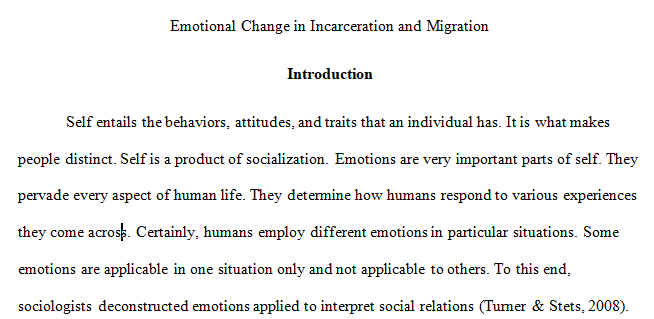
explain how certain emotions unique to the process of incarceration and migration are deconstructed and reconstructed?
Emotional Change in Incarceration and Migration
5 pages
- 1-inch margins
- Times New Roman 12-point font
- Bibliography in APA format
- Deeply integrate 3-4 course readings
- Have page numbers
- Pay attention to clarity, coherence, organization, and correctness of spelling/grammar in writing.
- NO LATE PAPERS will be accepted after the deadline
With all of these factors considered, and focusing on the two cases described above (prison and migration), 1) explain how certain emotions unique to the process of incarceration and migration are deconstructed and reconstructed? 2) Also, to what degree? 3) How emotions norms, emotional display, emotion management and emotional labor go through the same process of deconstruction and reconstruction? In other words, how and to what extent, do emotions change (emotional norms, display, and management), when people transition between two different “socio-cultural backgrounds” (i.e., from a free society to prison, and from a country of origin to new/host country)? 4) Use the theories of the self and symbolic interactionism to describe these processes.
outline:
- In your introduction, open with an explanation of what the self is. Remember that the self is not static but changes with interaction. Don’t forget to have a strong thesis statement (aka, what is your argument?) and indicate what you will use as your case, prison and/or migration?
- Then here you can talk about symbolic interactionism. Why are symbols important? Think about how the meaning of the symbols changed from a free society to prison? Or from one country to another country? How are the symbols being interpreted? Cite and/or provide examples that can help illuminate symbolic interactionism within the context of prison or migration. If pertinent, you can also talk about looking glass self, I and the ME, generalized other.
- Then, here you can begin discussing your case (prison and/or migration). How do a person’s emotions changed when they experience imprisonment or migration? How are the emotion norms/rules in prison and/or migration? Do they change? Do they remain the same? If they change, how much? Make sure to cite readings.
- How does emotional management help with this transition? And How i.e. fronting, masking, etc.? For example, how does emotional management help when a free person becomes a prisoner. Or when a person migrates to another country (goes from being non-migrant to migrant) Provide examples and/or cite another reading.
- How is emotional labor enacted inside prison and/or after migration? And how? Is this consider shadow labor? Also, how are they engaging in emotional labor, i.e surface acting, deep acting? Cite and/or provide examples and explain.
- Conclusion
- Bibliography: APA (only in text-citation and bibliography) I don’t expect title page and abstract.
readings : https://drive.google.com/drive/folders/1IMNrMA0yX1bTt2byYzGWYJ13KINHrJ2T
(the names have nothing to do with the paper) – use the attached sourecs and cite them, don’t mind how the documents are labelled/their file names such as question1, quetsion2, don’t mind these labels just read the files and reference and cite them
subject: Masters Social Science
Answer preview…………………..
 apa 1532 words
apa 1532 words